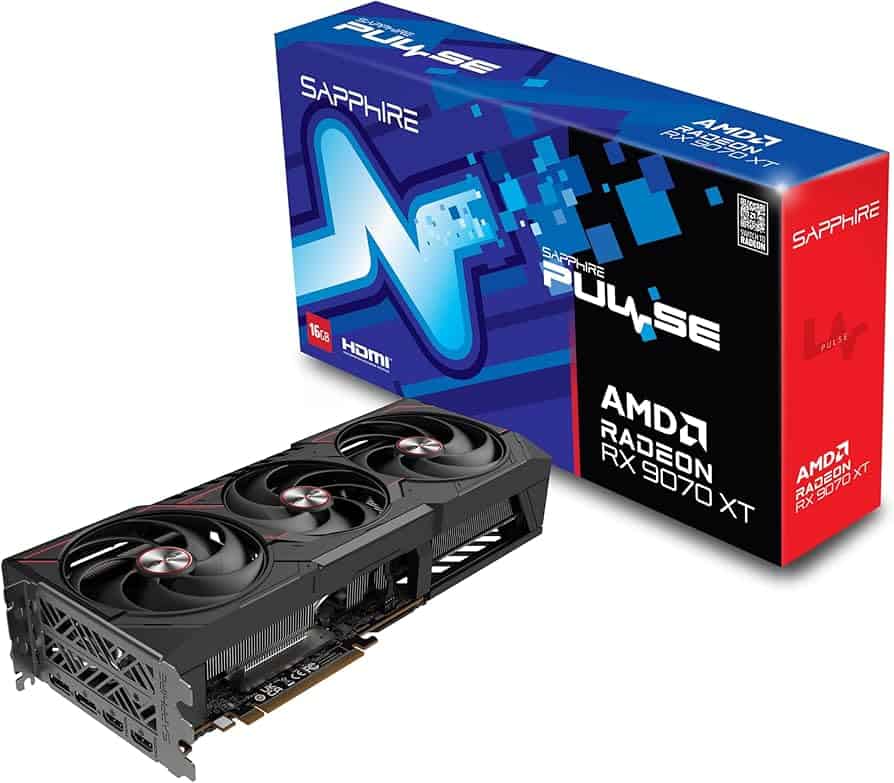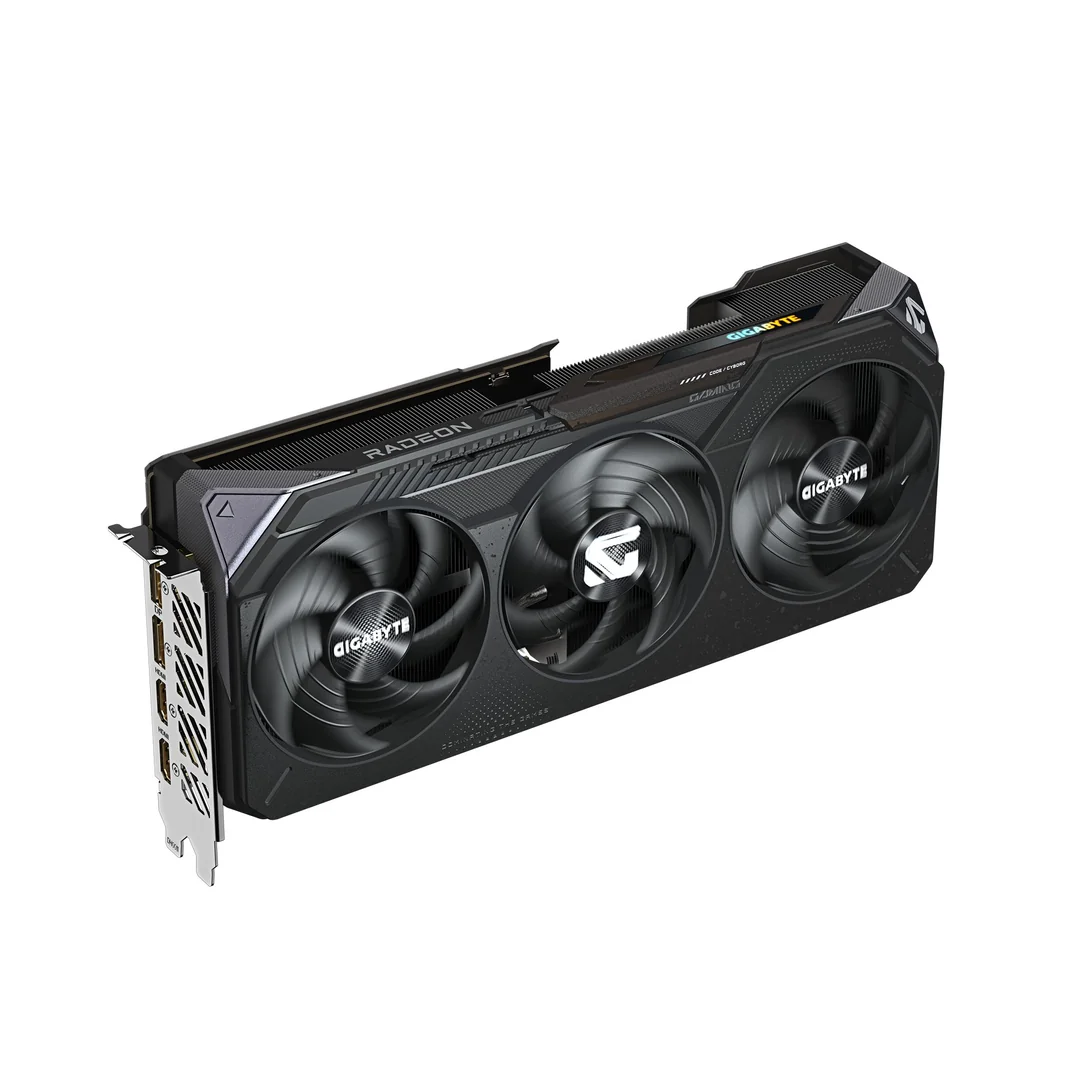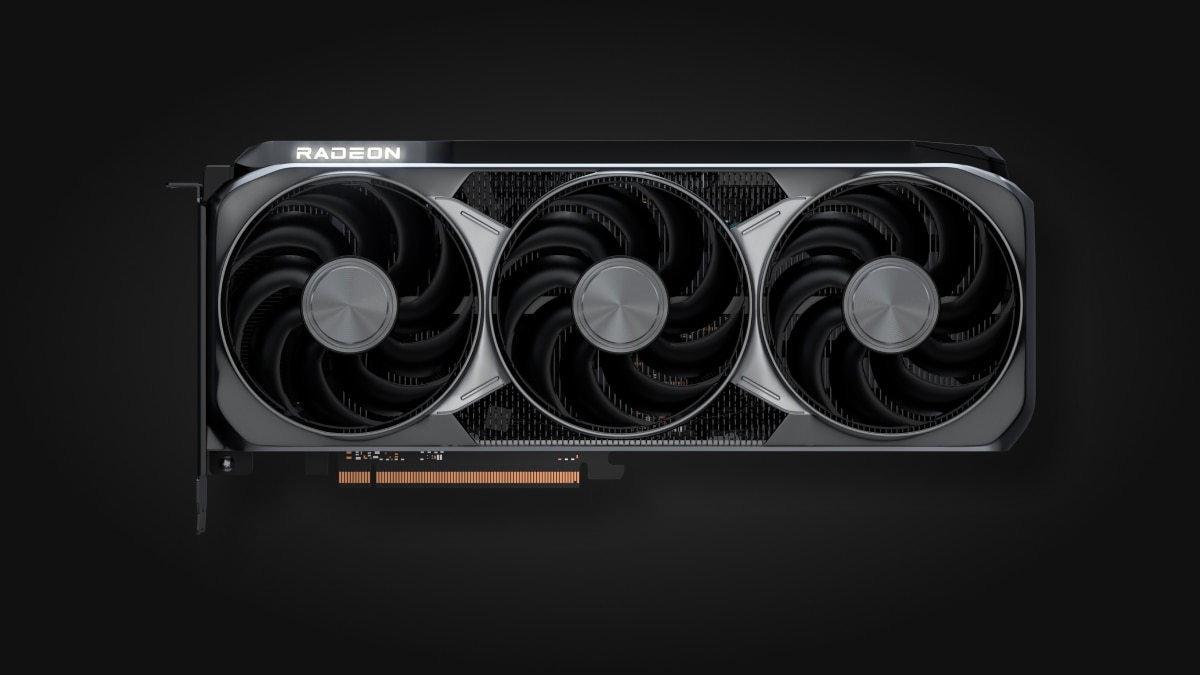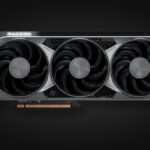AMD’s Radeon RX 9070 and RX 9070 XT graphics cards are positioning themselves as serious disruptors in the mid-range GPU segment, offering performance that edges into high-end territory at a more accessible price point. Built on the latest RDNA 4 architecture, these cards deliver substantial gains in both efficiency and raw performance, all while taking direct aim at Nvidia’s recently released RTX 5070.
RDNA 4 Brings Big Gains for Mid-Range
The RX 9070 is packed with 3,584 stream processors, 112 AI accelerators, and 56 ray tracing cores, backed by 16GB of GDDR6 memory across a 256-bit bus. The 9070 XT version increases frequency and performance for enthusiasts seeking more headroom. Both cards boast a 220W TDP, showing AMD’s continued effort to balance power efficiency with output.

Unlike the RDNA 3 series, RDNA 4 introduces architectural changes that emphasize ray tracing throughput and AI-assisted rendering. These shifts are critical as AMD continues to close the gap on Nvidia’s historically superior real-time ray tracing and AI performance.
Performance Benchmarks: Strong at 1440p and 4K
In early benchmarks, the RX 9070 shines at 1440p and 4K—two key battlegrounds for serious gamers.
- Call of Duty: Black Ops 6 – 70 FPS at 4K ultra settings (without frame generation), slightly ahead of RTX 5070’s 67 FPS.
- The Last of Us Part I – RX 9070 posts 24% better performance at 1440p and up to 37% at 4K compared to its Nvidia rival.
- Starfield – Outpaces the RTX 5070 by 31% at 1440p and 36% at 4K, which is significant for a title often used as a benchmark for system strain.
That said, not all results favor AMD. In Hunt: Showdown 1896, the RX 9070 lags behind Nvidia’s RTX 5070 by double-digit percentages. These inconsistencies suggest that while RDNA 4 is impressive, optimization per game still plays a major role.

MSRP vs. Reality: Pricing Confusion at Launch
The RX 9070 launched at $549 and the 9070 XT at $599, pricing them competitively against Nvidia’s RTX 5070 ($599 MSRP). However, the market response has been rocky. Due to limited launch stock and retailer markups, many buyers are seeing prices well above MSRP—some models nearing $800 for overclocked variants.
AMD has publicly acknowledged the issue and promised to improve supply to keep pricing grounded. But as of now, availability remains tight, and retailers are capitalizing on demand.
Thermal Issues and Cooling Concerns
Some early adopters reported VRAM thermal issues, especially in Gigabyte’s RX 9070 XT models. Investigations found that these cards used thermal gel instead of pads, leading to elevated temperatures under load. Enthusiasts replacing the gel with high-quality thermal pads reported a 7°C drop in VRAM temps—a meaningful improvement for longevity and performance stability.
FSR 4.0 and the Path to AI Gaming
The RX 9070 series benefits from FidelityFX Super Resolution (FSR) 4.0, AMD’s answer to Nvidia’s DLSS 3. While still not quite as refined, FSR 4.0 has made impressive strides in both image quality and frame generation. It’s particularly appealing for gamers who want high frame rates without sacrificing resolution.
A future update—codenamed Redstone—is rumored to bring advanced neural rendering features that will aid in more complex lighting techniques like path tracing, further narrowing the gap between AMD and Nvidia’s AI gaming toolsets.
Final Verdict: A Mid-Range King With High-End Muscle
AMD’s Radeon RX 9070 series is a shot across Nvidia’s bow. With excellent performance at 1440p and 4K, competitive pricing (if you can get it at MSRP), and improving software tools like FSR, it’s a smart buy for gamers wanting cutting-edge performance without spending over $1,000.
Still, those interested should keep an eye on stock levels and cooling performance—especially if they’re considering specific AIB partners. If pricing stabilizes, the RX 9070 could very well become the go-to GPU for serious gamers in 2025.
RX 9070 vs RX 9070 XT
Here’s a detailed comparison of the AMD Radeon RX 9070 vs RX 9070 XT to help you understand the differences in specs, performance, and value:
AMD Radeon RX 9070 vs RX 9070 XT
| Feature | Radeon RX 9070 | Radeon RX 9070 XT |
|---|---|---|
| Architecture | RDNA 4 | RDNA 4 |
| Stream Processors | 3,584 | 4,096 |
| AI Accelerators | 112 | 128 |
| Ray Accelerators | 56 | 64 |
| Base Clock | ~2.2 GHz (varies by AIB) | ~2.4 GHz |
| Boost Clock | Up to 2.52 GHz | Up to 2.72 GHz |
| VRAM | 16GB GDDR6 | 16GB GDDR6 |
| Memory Bus | 256-bit | 256-bit |
| Memory Bandwidth | ~576 GB/s | ~576 GB/s |
| TBP (Total Board Power) | 220W | 265W |
| MSRP | $549 | $599 |
| 4K Gaming Performance | Strong | Stronger + More Stable Frame Rates |
| Ray Tracing Performance | Good | Slightly better |
| Thermal Design | Cooler (lower power draw) | Runs warmer under load |
| Overclocking Headroom | Moderate | Higher OC potential |
| Target Audience | Value-focused gamers | Enthusiasts wanting top-tier mid-range power |
Key Differences
- Performance: The RX 9070 XT generally offers a 5–15% performance boost over the base RX 9070 in most titles, thanks to higher clock speeds and more compute units. It’s especially noticeable at 4K or with ray tracing enabled.
- Power & Cooling: The XT model consumes more power (265W vs 220W), which can lead to higher temperatures and louder fans unless cooled effectively.
- Price-to-Performance: While both offer great value, the base RX 9070 has a better price/performance ratio if you’re gaming at 1440p and don’t need max settings or max ray tracing.
Which One Should You Buy?
- Choose RX 9070 if you’re gaming at 1440p, want good performance for less money, and prioritize efficiency and quieter operation.
- Choose RX 9070 XT if you want more future-proofing, plan to game at 4K with ray tracing, or want extra performance for streaming, content creation, or high-FPS gaming.
Both cards are excellent in their segment, but the decision ultimately depends on your budget, resolution, and performance expectations.
Key Takeaways
- The Radeon RX 9070 and 9070 XT are priced at $549 and $599 respectively, offering high-end performance at mainstream prices.
- Factory-overclocked premium models will cost more than the official MSRP, with some retailers expecting significant markups.
- AMD’s competitive pricing strategy directly challenges Nvidia and could benefit consumers by influencing overall GPU market prices.
Overview of AMD Radeon RX 9070 Series
AMD’s Radeon RX 9070 series brings next-generation graphics performance to the mainstream market with fixed pricing points and improved specifications over previous generations.
Technical Specifications and Architecture
The AMD Radeon RX 9070 series is built on the latest RDNA 4 graphics architecture, offering significant performance and efficiency improvements. The lineup includes two models:
- RX 9070: Priced at $549
- RX 9070 XT: Priced at $599
Both cards feature more VRAM than their competitors, giving them an edge in memory-intensive gaming tasks. The RX 9070 XT boasts higher compute units and boost clock speeds than the standard RX 9070, explaining its $50 price premium.
The cards use advanced 7nm manufacturing technology that helps reduce power consumption while maintaining high performance levels. This makes them suitable for gamers who want powerful graphics without excessive power draw.
AMD has optimized the memory bandwidth to handle 4K gaming more effectively, though results will vary by game title and settings.
Enhancements in Ray Tracing and AI-Powered Features
The RX 9070 series brings major improvements to ray tracing capabilities. AMD has strengthened the dedicated ray tracing accelerators, allowing for more realistic lighting, shadows, and reflections in supported games.
Ray tracing performance has jumped significantly compared to the previous generation. Games that use ray tracing now run smoother, with higher frame rates even at challenging settings.
AI acceleration has also received attention in this generation. New AI accelerators help with:
- DLSS-like upscaling: Creating sharper images from lower resolutions
- Frame generation: Inserting AI-created frames to boost perceived performance
- Background removal: For streamers and content creators
These AI features help the cards deliver better performance in modern games without requiring raw power increases alone. The implementation is more efficient than in past generations.
Comparison with Previous Generations
The RX 9070 series delivers impressive performance gains over its predecessors. Early benchmarks suggest the standard RX 9070 outperforms even the previous-generation RX 7900 XTX in some scenarios, despite the lower price point.
Key improvements include:
- 15-20% better frame rates in standard rasterization
- 25-30% improved ray tracing performance
- 40% better power efficiency compared to RDNA 3
The new cards offer better value than the 7000 series, delivering more performance per dollar. This positions them as strong competitors in the mid-to-high end graphics market.
For gamers upgrading from cards that are several generations old, the performance jump will be substantial. The improvements in both raw gaming performance and modern features like ray tracing make these cards compelling options for anyone building a new gaming PC in 2025.
Pricing and Market Positioning
AMD’s new Radeon RX 9070 series enters the market with aggressive pricing designed to challenge NVIDIA’s dominance in the mid-range GPU segment. The price points chosen for these cards represent a strategic move to capture market share.
Retail Pricing and Availability
The Radeon RX 9070 arrives with an MSRP of $549, while its more powerful sibling, the RX 9070 XT, is priced at $599. These price points are noteworthy in today’s GPU market. The cards officially launched in March 2025, though actual availability in stores has been somewhat mixed.
Some retailers have reportedly canceled preorders for the cheaper RX 9070, raising concerns among consumers. AMD executive Frank Azor has addressed this issue, stating that AMD will encourage retailers to sell the RX 9070 XT at MSRP.
Actual retail prices may vary depending on regional taxes, tariffs, and retailer markup. Gamers should monitor trusted retailers for the best deals as inventory stabilizes.
Comparison to Competing NVIDIA Products
AMD has positioned the RX 9070 XT directly against NVIDIA’s RTX 5070 Ti, which carries a significantly higher $749 MSRP. This $150 price difference represents substantial savings for consumers with comparable performance.
In benchmarks shared by AMD, an overclocked RX 9070 XT reportedly shows a 2% performance lead over the standard RTX 5070 Ti in select games. This performance-per-dollar advantage is a key selling point for AMD.
The standard RX 9070 ($549) also competes favorably with NVIDIA’s offerings in the mid-range market. AMD’s RDNA 4 architecture powers both cards, delivering improved efficiency over previous generations.
For budget-conscious gamers looking to build a capable gaming PC, AMD’s pricing strategy makes the 9070 series particularly attractive.
Impact on PC Gaming Market
AMD’s aggressive pricing approach may force NVIDIA to reconsider its own pricing strategy for the GeForce RTX 50 series. This competition benefits consumers through lower prices across the board.
The mid-range GPU segment is crucial for most PC gamers who want good performance without spending premium prices on flagship cards like the RTX 5090. AMD’s competitive offerings here could significantly increase their market share.
System builders can now offer more affordable gaming PCs with strong graphics performance. This accessibility helps expand the PC gaming market by lowering the entry cost for quality gaming experiences.
The $599 MSRP for the RX 9070 XT represents a sweet spot in price-to-performance ratio that many gamers will find appealing for 1440p gaming and entry-level 4K experiences.
Frequently Asked Questions
The AMD Radeon RX 9070 Series has generated significant interest among gamers and PC enthusiasts with its pricing structure and availability becoming hot topics of discussion.
What is the MSRP for the AMD Radeon RX 9070 Series?
The AMD Radeon RX 9070 has an MSRP of $549, while the RX 9070 XT is priced at $599. These prices position both graphics cards in the mainstream segment.
Some concerns have emerged about these prices only applying to initial shipments. However, AMD has stated, “It is inaccurate that $549/$599 MSRP is launch-only pricing.”
The company expects cards to be available from multiple vendors at these price points, excluding special editions.
Where can I find the AMD Radeon RX 9070 Series for sale online?
The Radeon RX 9070 Series is available through major computer hardware retailers and AMD’s official retail partners. Popular online stores like Newegg, Amazon, and Best Buy typically carry these graphics cards.
AMD’s official website also provides links to authorized retailers where customers can purchase the cards. Stock levels vary between retailers, so checking multiple sources is recommended.
When was the AMD Radeon RX 9070 XT officially released?
The AMD Radeon RX 9070 XT was released as part of AMD’s RDNA 4 architecture launch. The cards became available for purchase in early 2025.
The launch followed AMD’s typical pattern of releasing mainstream cards before introducing their higher-end products. This strategy allowed gamers to access the new architecture at more affordable price points.
Are there any pre-order options available for the AMD Radeon RX 9070 XT?
Pre-order options for the Radeon RX 9070 XT were available through select retailers before the official launch. Currently, standard ordering is available as the cards have already been released.
Some retailers may offer waiting lists or notification systems for when new stock arrives. This is particularly useful given the high demand for these graphics cards.
What notable features and specifications define the AMD Radeon RX 9070 Series?
The RX 9070 Series features AMD’s RDNA 4 architecture, offering improved performance over previous generations. These cards provide excellent 1440p gaming performance and can handle some 4K gaming scenarios.
Key specifications include enhanced ray tracing capabilities, improved power efficiency, and AMD’s latest software features. The cards also support AMD’s FidelityFX Super Resolution technology for boosting frame rates.
Both models include hardware-accelerated ray tracing and variable rate shading, technologies that improve visual quality in supported games.
Has the AMD Radeon RX 9070 XT been facing stock shortages since its launch?
There have been some stock challenges with the RX 9070 XT, though not as severe as with previous GPU generations. Initial shipments sold quickly at the $599 MSRP.
Some retailers have reported limited availability, particularly for cards at the base MSRP. This situation has led to concerns about price increases beyond the initial batches of cards.
AMD has stated they expect multiple vendors to maintain the official pricing, though “special edition” cards may command premium prices.







